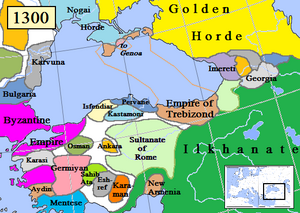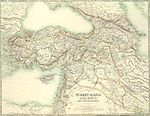Pervâneoğlu
Pervâneoğlu is a topic of great relevance today, since it has aroused the interest of numerous people around the world. Since its emergence, it has generated a wide range of opinions and discussions, as well as having an impact on various areas of society. Its importance lies in the influence it has on people's daily lives, as well as its potential to generate significant changes in different aspects. In this article, we will explore in detail the various facets and repercussions of Pervâneoğlu, with the aim of providing a complete and enriching analysis of this topic that is so relevant today.
This article needs additional citations for verification. Please help improve this article by adding citations to reliable sources. Unsourced material may be challenged and removed. Find sources: "Pervâneoğlu" – news · newspapers · books · scholar · JSTOR (August 2021) (Learn how and when to remove this message) |

Pervâneoğlu (in Turkish plural Pervâneoğulları, 'sons of the pervâne') or Beylik of Sinop was an Anatolian beylik that existed between the second half of the 13th century and the beginning of the 14th (1261–1326).
The beylik was founded by Mu'in al-Din, Seljuk pervâne of Persian origin. His grandson Gazi Çelebi, the last Bey of Pervane, transformed his realm into a serious regional naval power, conducting raids against Genoese possessions in the Black Sea and Crimea, as well as against the Empire of Trebizond. Having no sons, Gazi Çelebi bequeathed his lands to the Candarids.
See also
References
- ^ Muharrem Kesik, "Pervâneoğulları", TDV Diyanet İslam Ansiklopedisi, Ankara 2007, c. XXXIV, s. 245-246
- ^ Donzel, E. J. van (1 January 1994). Islamic Desk Reference. BRILL. p. 290. ISBN 90-04-09738-4.
Muin* al-Din Sulayman Parwana: de facto ruler of the Saljuq state of Rum in Anatolia during most of the Mongol Protectorate; d. 1277. Of Persian stock, he attempted to maintain stability both amongst the Turkish emirs and between them and the ever-increasing number of Mongols resident on Anatolian soil. He is said to have enjoyed a close relationship with Jalal al-Din Rumi.
| |||||||||||||||||||||||||||||||||||||||||||||||||||||||||||||||||||||||||||||||||||||||||||||||||||||||||||||||||||||||||||||||||||||||||||||||||||||||||||||||||||||||||||||||||||||||||||||||||||||||||||||||||||||||||||||||||||||||||||||||||||
| |||||||||||||||||||||||||||||||||||||||||||||||||||||||||||||||||||||||||||||||||||||||||||||||||||||||||||||||||||||||||||||||||||||||||||||||||||||||||||||||||||||||||||||||||||||||||||||||||||||||||||||||||||||||||||||||||||||||||||||||||||
| |||||||||||||||||||||||||||||||||||||||||||||||||||||||||||||||||||||||||||||||||||||||||||||||||||||||||||||||||||||||||||||||||||||||||||||||||||||||||||||||||||||||||||||||||||||||||||||||||||||||||||||||||||||||||||||||||||||||||||||||||||
States in late medieval Anatolia (after 1071) | |
|---|---|
| Muslim states |
|
| Christian states | |
